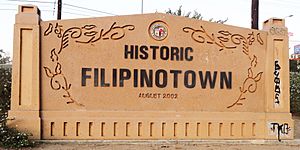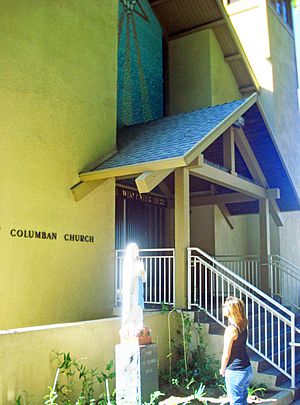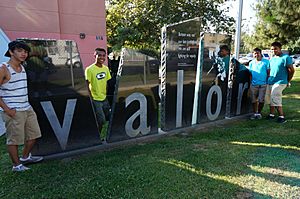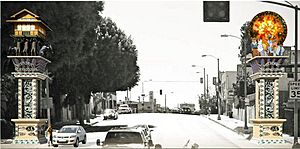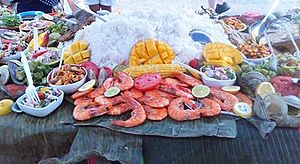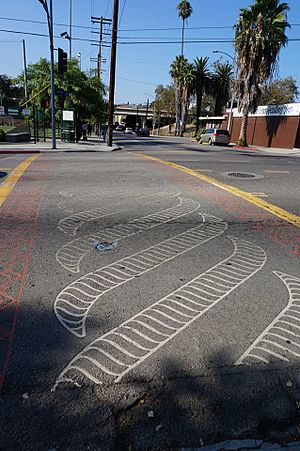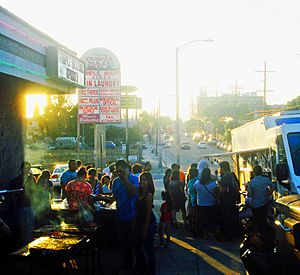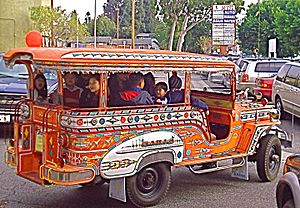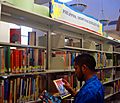Historic Filipinotown, Los Angeles facts for kids
Quick facts for kids
Historic Filipinotown
|
|
|---|---|

Historic Filipinotown signage located at
Beverly Boulevard and Belmont Avenue |
|
| Nickname(s):
HiFi
|
|
| Country | |
| State | |
| County | |
| Time zone | Pacific |
| Zip Code |
90026
|
| Area code(s) | 323 |
Historic Filipinotown (alternately known as HiFi ) is a neighborhood in the city of Los Angeles. It is one of the six Asian Pacific Islander neighborhoods (Chinatown, Little Tokyo, Historic Filipinotown, Little Bangladesh, Koreatown, and Thai Town) in the city.
Contents
Historical Background
The district is the first official geographic designation by any city outside the Philippines honoring Filipinos. From a political and community planning standpoint, Historic Filipinotown is in the city of Los Angeles’s Thirteenth District, represented by council member Mitch O'Farrell. It overlaps, and is even divided by, the two larger communities of Silver Lake and Echo Park. Historic Filipinotown was created to help continue the history of this part of the neighborhood and promote economic, civic, commercial, cultural, industrial, and educational interests and common wealth of local residents, business owners, and other stakeholders. Community plans drawn up for Historic Filipinotown also impact the community plans of Silver Lake-Echo Park and a small section of Westlake south of Beverly Boulevard. As a result, Historic Filipinotown must compete with these other localities for services and benefits while avoiding any conflict with their larger community parents.
Filipino Americans represent the largest population of Asian Americans in California and also have one of the oldest communities of Asian Americans in the United States. The earliest settlement can be found in enclaves such as Manila Village in Jefferson Parish and St. Malo in St. Bernard Parish in Louisiana which were founded in 1763 and became home to approximately 2,000 Filipino sailors and laborers. With houses plat-formed on stilts, the fishermen caught and dried their precious commodity, shrimp, for export to Asia, Canada, South and Central America. They introduced innovations such as "dancing the shrimp" and shrimp farming to the United States. Weather conditions eventually destroyed St. Malo in 1915 and Manila Village in 1965. On July 24, 1870, the Spanish-speaking residents of St. Malo founded the first Filipino social club called Sociedad de Beneficencia de los Hispano Filipinos to provide relief and support for the group’s members, including the purchasing of a burial places for their deceased.
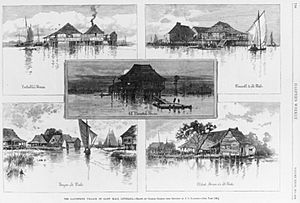
Despite the fact that there are other enclaves of Filipinos living outside this district (such as Carson, Cerritos, West Covina, Panorama City, and Eagle Rock) it was named "Historic Filipinotown" since it was one of the few areas where Filipinos first settled during the early part of the 20th century and home to key Filipino organizations, Filipino churches (Filipino Christian Church, Iglesia ni Kristo, St. Columban Filipino Catholic Church, United Church of God Ministries, Praise Christian Fellowship, and Congregational Christian Church), housing (Manila Terrace, Mindanao Towers, Mountain View Terrace, and Villa Ramos), and social service centers. Many Filipino American families began purchasing homes and establishing businesses in the area beginning from the 1940s, shifting away from the downtown area now known as Little Tokyo in the 1920s and the Bunker Hill area later.
In a section of downtown Los Angeles now known as Little Tokyo, a thriving community known as Little Manila existed and flourished for over two decades (1920s-1940s). The first significant wave of Filipino migration came in 1923, when over 2,000 arrived in California. Ten years later, over 6,000 resided in Los Angeles, most living in the downtown neighborhood bordered by San Pedro Street to the east, Sixth Street to the south, Figueroa Street to the west, and Sunset Boulevard to the North. Twelve restaurants, seven barbershops, the immigrant newspaper The Philippines Review, and the Manila Portrait Studio all helped to buoy the Los Angeles Filipino diaspora. Many of the Filipino pioneers came to Los Angeles to study, while others settled as residents for employment. This community of mostly males established numerous restaurants, pool halls, café's, employment agencies and barbershops which became the hub where Filipinos congregated, lived, socialized, organized, and networked among their compatriots to find companionship, fellowship and work. One would merely drive to First and Main Streets to solicit Filipinos; either by Hollywood studios in need of ethnic-type extras for cinematic productions or many others in need of cheap labor.
While gambling and taxi dancehalls provided the overwhelmingly male Filipino community with distraction from their grinding labor, these activities drew condemnation from some quarters within Little Manila. Boxing, however, drew no such criticism; moreover, it brought a diverse population -- sometimes divided ethnically between Ilocanos, Visayans, Tagalogs, and Boholanos -- together into one experience. "They didn't care if a person was Visayan, Ilocano, Boholano, Cebuano," notes Stockton's Jerry Paular. When a Filipino boxer emerged victorious, "Ilocano was embracing the Visayan and the Tagalog." In Los Angeles, Johnny Samson, one of only two Filipino boxing trainers at the time, served as chairman of the L.A. Filipino Unity Council. Boxing would prove to be one of the most influential and lasting forms of popular attraction among Filipinos in California. Some historians also believe that Filipinos in Los Angeles were the original wearers of Zoot Suits. According to Rudy Estrada, an original Zoot Suiter who was attacked while walking in downtown Los Angeles in 1944: “Chicanos didn’t invent the Zoot Suit style; it was the Filipinos. Ducktail hairdos—Filipinos started that, too.”
In recent times the population of Historic Filipinotown has changed to reflect the ethnically diverse nature of Los Angeles. While the district still has a sizeable Filipino population, they are the minority, overshadowed by a sizeable Mexican and Central American population. Nevertheless, the area still has one of the highest concentrations of Filipino Americans in Southern California and still remains the cultural heart of Filipinos throughout Los Angeles. Of the 600,000 Filipinos that reside in the Los Angeles metropolitan area, an estimated 10,000 live within Historic Filipinotown. Nearby Chinatown also has about the same number of Chinese residents living within their own district. Though the population of Historic Filipinotown, or "Hi-Fi" (Garcetti's preferred shorthand moniker), is roughly 25 percent Filipino, it still boasts a higher ratio of Filipinos than nearby Koreatown has Koreans (15 percent) and Thai Town has Thais (less than 5 percent).
On October 31, 2011, Historic Filipinotown was officially recognized as one of the nation’s Preserve America Communities after years of advocacy by the Pilipino American Network and Advocacy ( PANA ) and other community advocates. Receiving this honor from First Lady and Honorary Chair of the Preserve America Initiative, Michelle Obama, Historic Filipinotown is provided with strong federal support and incentives for the continued preservation of cultural and natural heritage resources. As a Preserve America Community, Historic Filipinotown is featured in the National Register Travel Itineraries and in “Teaching with Historic Places” curricular materials created by the National Park Service.
On January 28, 2012, representatives from Preserve America and the California State Historic Preservation, as well as various elected officials and community leaders gathered at Unidad Park for “Preserving Historic Filipinotown: A Community Celebration.” In addition to the official ceremony of Historic Filipinotown’s Preserve America designation, this celebration also honored the restoration of the mural at Unidad Park, as well as the designation of Remedios “Remy” V. Geaga Square, located at the intersection of Alvarado Street and Temple Street.
Historic Filipinotown stands to remind the City of Los Angeles and Filipino Americans about the history and struggles Filipinos have overcome to build this particular community. Historic Filipinotown is a place that both serves the Filipino community and also provides avenues for all Angelenos and visitors alike to enjoy Filipino cuisine, support neighborhood businesses, visit the Historic Filipinotown cultural landmarks and attend Historic Filipinotown events– all through which one can learn and engage in preserving the rich cultural heritage of Filipino Americans in Los Angeles.
Historic Filipinotown Neighborhood Council ( HIFINC )
The Historic Filipinotown Neighborhood Council ( HIFINC ) leads the effort for cultural, political, and economic development in the district. Many Filipino service organizations and institutions, such as the Filipino Christian Church (designated with a cultural marker by the City of LA), Rotary Club of Historic Filipinotown (HIFIRC), the Pilipino Workers Center (PWC), Filipino American Community of Los Angeles (FACLA), Filipino American Service Group (FASGI), Search to Involve Pilipino Americans (SIPA), Pilipino American Network and Advocacy (PANA), the Filipino American Library (FAL), and the Historic Filipinotown Chamber of Commerce (HIFICC) are located in the neighborhood. The area is also host to Filipino restaurants, churches, and hospitals and medical clinics.
The three major annual events in Historic Filipinotown are the Annual Historic Filipinotown Festival with the Annual Historic Filipinotown 5k Run/Walk (sponsored by Historic Filipinotown Neighborhood Council), which is held every first Saturday of August, commemorating the designation of the District as the Historic Filipinotown. The Festival showcases the people and cultures of the residents of district with music, dances, food, entertainment, and health fair; and Philippine Independence Day Parade and Festival (co-sponsored by FACLA) held every first Saturday of June to celebrate the national day of the Philippines; and, the annual Christmas Lantern Parade and Festival( sponsored by the Historic Filipinotown Neighborhood Council). Following Thanksgiving, the lamp posts along Temple Street are decorated with Philippine Christmas lanterns ( Parol ) as the launching of the Christmas festivities, which last until the Epiphany Celebration the following year. The Christmas Parol Project was several years in the making due to City Code requirements and fund raising challenges. In 2008, Historic Filipinotown Neighborhood Council was able to raise enough funds to launch the annual event with a Christmas Lantern Parade on Temple Street.
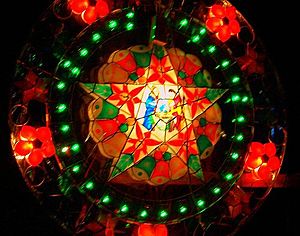
Cultural Landmarks
- Filipino Christian Church, and St. Columban Filipino Catholic Church
On May 5, 1998, the Los Angeles City Council designated the Filipino Christian Church as Los Angeles Historic-Cultural Monument No. 651.
The Filipino (Disciples) Christian Church is the only Historic Cultural Monument designated by the City of Los Angeles with Filipino origins, distinguished by its German Gothic Revival and Craftsman architecture. The Disciples of Christ State Board adopted the work with the Filipinos as its mission and called on Rev. and Mrs. Frank Stipp, former missionaries to the Ilocos provinces, to oversee the work. Through them and the Disciples of Christ State Board, a center was later started when the Disciples secured for the Filipino Christian Fellowship four bungalows complete with apartment facilities and a worship place located at First and Bunker Hill, where the Music Center and Disney Concert Hall stand today. It is believed that these quarters sparked the start of what is known now as Historic Filipino Town. Having been the earliest Christian church established to cater to Filipino Americans, many key organizations in the area germinated from this church, including SIPA and the Filipino American Library.
Purchased in part by funds donated by First Lady Aurora Quezon as a gift to the Filipinos in Los Angeles: the St. Columban Filipino Church on Beverly Blvd and Loma Drive so has authentic church bells from Antipolo City, Philippines. The church sits on one of the five hills that circled the old Los Angeles; this hill is called Crown Hill. In the 1890s Crown Hill was the epicenter of a massive oil boom when Edward L. Doheny and Charles A. Canfield bought a lot at Colton Street and Glendale Boulevard; in November 1892 they struck oil and the boom was on.
- Gintong Kasaysayan, Gintong Pamana mural
Prior to the area being designated as Historic Filipinotown, on June 24, 1995, the nation's largest Filipino American mural, Gintong Kasaysayan, Gintong Pamana (Filipino Americans: A Glorious History, A Golden legacy), was unveiled. In 1997, the City of Los Angeles Board of Cultural Affairs Commissioners awarded the mural its first ever Award of Design Excellence for public art. The mural was likewise featured in Los Angeles County Museum's 'Made in California: Art, Image and Identity 1900-200', the Smithsonian Institution's traveling exhibition celebrating 100 years of Filipino migration to the USA called 'Singgalot (The Ties That Bind): From Colonial Subjects to Citizens' and the Smithsonian Traveling Exhibition, "I Want the Wide American Earth" honoring the history and contributions of Asian and Pacific Islanders in the United States. The mural was painted by then 22-year-old artist Eliseo Art Silva while a junior attending Otis College of Art and Design. According to the artist, "...the mural encapsulates 5,000 years of Filipino and Filipino American history; the design is divided into two parts: the first is historical (represented by the outline of a fish at sea), leading up to the awakening of Filipino national and political consciousness; the second part is dominated by a huge bird with significant Filipino-Americans on its wings, the farm workers on the bottom left and the youth and community on the right."
- Unidad Park
The mural originally faced a large community garden called the Candy Chuateco Community Garden. Sponsored by Search to Involve Pilipino Americans, The land was purchased by the City of Los Angeles and converted into the Unidad Park through the Los Angeles Neighborhood Land Trust (LANLT). Unidad Park's design was conceptualized by leaders and stakeholders of the Filipino community and based largely from submitted renderings by the mural artist Eliseo Silva, which includes the Philippine Bontoc/Kankana-ey communal gathering place, park features and a community garden referencing the Rice Terraces of the Philippine Cordilleras, a UNESCO World Heritage Site, as well as an entrance walkway based on a design by Filipino American Pedro Flores. The park is a popular destination for the neighborhood with its Dap-ay used by students and the sandbox inside this space used by toddlers, the interactive play area, community garden as well as onsite barbecue grills with matching tables and benches for family gatherings and parties, enhanced by a covered tent to protect park users from the sun and rain.
- Hi-Fi Signage, Street Medallions (Banners) and Crosswalks
In 2007, CALTRANS and the Historic Filipinotown Neighborhood Council ( HIFINC ) with financial support from the community, installed Historic Filipinotwn signage along the US 101 Freeway directing traffic to the area with the Alvarado and Glendale Blvd. exits. The crosswalks in Filipinotown have been decorated with traditional Filipino basket-weaving patterns designed by Edwin Frederizo who also designed Hi-Fi's street banners. According to the artist, "My design for the permanent art display conveys a message of peace, unity, and harmony amongst the community of Historic Filipinotown. The uniqueness of having Filipino American residents and businesses embedded within a variety of cultures allows for a very rich and conceptual visual art display. The Filipino American culture is influenced by several other cultures (i.e.- Latino, Chinese and African American) and is fused into a very unique style all its own."
- Filipino American WWII Veterans Memorial
In November 2006 Eric Garcetti, president of the LA City Council, joined Filipino veterans from around the country in unveiling the first monument dedicated to the 250,000 Filipino and 7,000 Filipino American soldiers who fought for the United States in World War II. The monument, located in Lake Street Park in the heart of Los Angeles’s Historic Filipinotown, consists of five slabs of polished black granite and commemorates the history of the Filipino veterans, from WWII to immigration to their subsequent fight for equality. It was designed by artist Cheri Gaulke.
- Future Plans
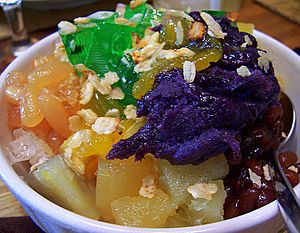
Future plans for Historic Filipinotown include a permanent structure for the Filipino American Library in honor of its founder Helen Summers Brown, the naming of a Filipino community and cultural arts center in honor of the catalyst for the 1965 Delano Grape Strike Larry Dulay Itliong, the naming of a community garden after community leader/educator Uncle Roy Morales and Filipino labor leader Philip Vera Cruz, a section of the neighborhood to be named in honor of Remedios Geaga and placing a larger than life size monument of Philippine national hero Jose Rizal and LA writer and novelist Carlos Bulosan in front of the Filipinotown Unidad park. An eastern gateway to Historic Filipinotown along Temple Street is in the planning and design stage for presentation to the Council members and approval by Los Angeles City authorities. Recently, the western gateway to Historic Filipinotown was unveiled, which is located at the corner of Temple St. and Silverlake Blvd. Residents have also suggested that district branding be more prominent to include public art that reflects Filipino culture more prominently to enhance the area as a tourist destination. Other long-term plans for the area include an anchor mall with an over-all design reflective of a fusion of the golden age of the Indianized Kingdoms of the Philippines with pre-WW2 Intramuros; as well as an "American Filipino Museum and Gallery of Art".
Gallery
-
At night, the area comes alive with Karaoke Nights at Luzon Plaza's Kapistahan Grill where anyone can be the star. Alongside a series of vibrant events, Sunday Jump is the only Filipino-founded open mic series held every 1st Sundays, providing a safe space for those to express free speech and uplift communities.
Demographics
In 2010, Latinos constituted approximately 66% of the population. Asians comprised about 25% – with Filipinos as the largest Asian American Pacific Islander (AAPI) subgroup. (Of the 25% of Asian Americans that resided in Historic Filipinotown at the time of the survey, 64% were Filipino.) Non-Hispanics Whites and Blacks each constituted 4% of the neighborhood.
Education
Schools
The following LAUSD schools lie within the established boundaries of Historic Filipinotown:
- Rosemont Elementary School, 421 Rosemont Avenue
- Alliance Ted K. Tajima High School, 1552 Rockwood Street
Samahang Pilipino Advancing Community Empowerment (SPACE)
Samahang Pilipino Advancing Community Empowerment (SPACE) is an access project created in 2000 by Samahang Pilipino at UCLA, the official student organization for the Pilipino and Pilipino American communities at UCLA. SPACE addresses and alleviate the barriers to higher education for at-risk, historically underrepresented, underserved high school and community college students in the Los Angeles area. Through peer tutoring, peer advising. student workshops, parent workshops, and field trips, SPACE promotes "academic success, personal well-being, community engagement, and the formulation of solid post-secondary plans".
In 2015, SPACE hosted Philippine Youth Empowerment Day, an event that featured workshops focused on Filipino-American history, identity and representation in the media.
Images for kids



